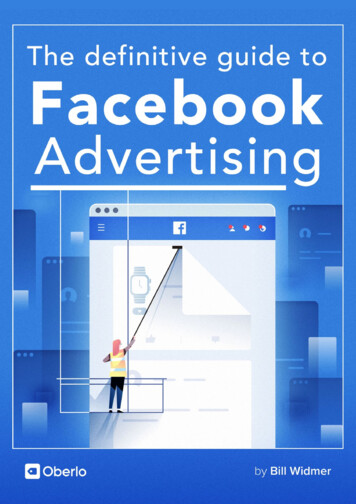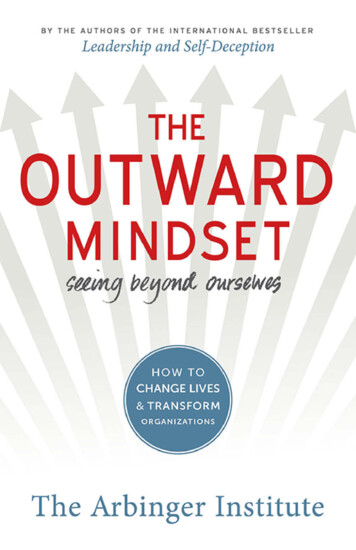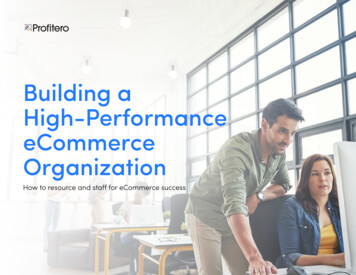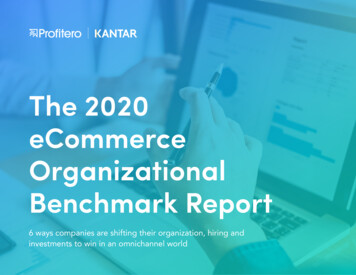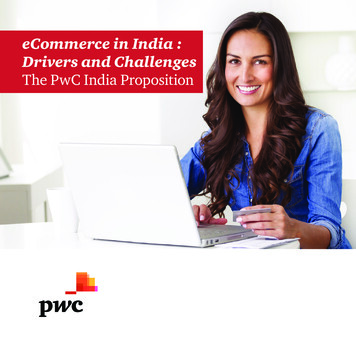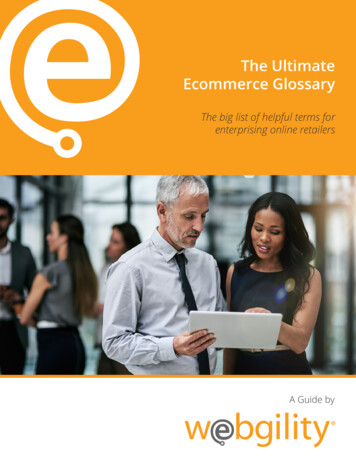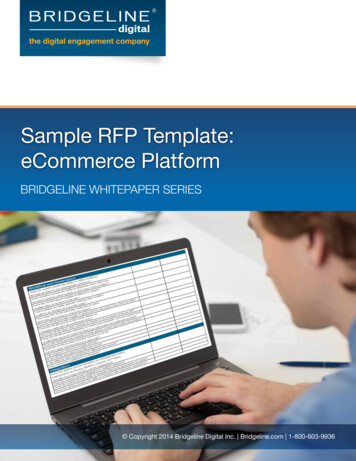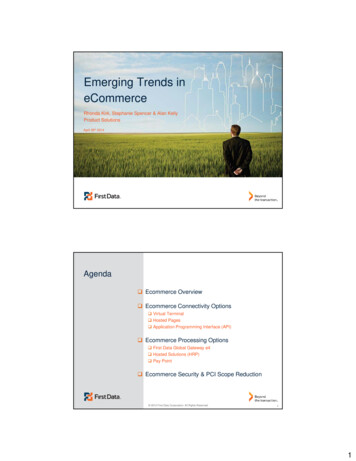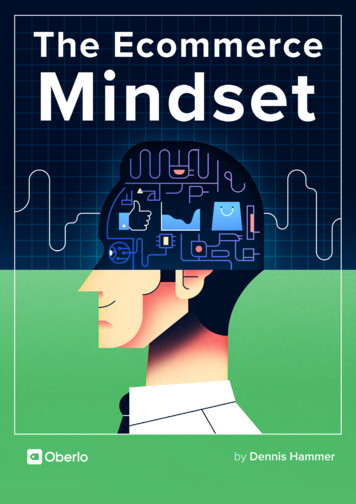
Transcription
Table of ContentsIntroduction1.Overnight Success is a MythEveryone Loves an Overnight Success StoryOvernight Success Just Doesn’t ExistThree Years of “Overnight Success”The Truth About Success2.In the Beginning, No One Cares About Your BrandBrands Means to an EndHumans are Creatures of HabitHow to Make People Care About Your Brand3.Your Mindset Affects EverythingChanging Your MindsetQualities of a Mindset Wired for Success4.It All Starts with a PlanA Word of CautionComponents of a Business PlanA Final Word of Caution5.The Serious Entrepreneur Has an Exit StrategyPlanning Your ExitGet Out When Things Are Good
6.Resourcefulness is More Important Than ResourcesHow to Become a More Resourceful EntrepreneurTurn Resourcefulness Into a Mindset7.What Makes You Unique?Every Store Needs a Unique Selling PropositionHow to Create Your USP8.Early Traction Meeting New PeopleThe Old-Fashioned WayNumb Yourself to RejectionThree Qualities You Need to Meet New People9.You Are Not Your CustomerHow to Get Out of Your Head and Into Your Customer’sCreate the Experience They Want10.Customers Expect a Clear, Pleasant ExperienceSigns of a Bad Customer ExperienceOptimize Over Time with Testing11.The Seduction of GiveawaysNever Run a Giveaway Out of Desperation12.SEO is NOT the Cure-AllSEO Won’t Solve All Your ProblemsThat Said, Don’t Ignore SEO
13.Every Business Needs AccountingAccounting 101: Track EverythingGet Comfortable with Your Taxes14.Customer Lifetime Value Matters More thanToday’s SaleCustomer Lifetime Value ExplainedCustomer Lifetime Value Unlocks an Important SecretCultivating a Relationship15.More Tools Won’t Solve All Your ProblemsTools Don’t Have All the AnswersChoose Tools That Support Your Process and StrategyFocus on Your Sticking Points16.Don’t be Lured by Slick SalespeopleThe Web Doesn’t Make Things EasyDon’t Be Afraid to HireLearn to Say “No”17.Copy and Images Make SalesPhotos: Shoppers’ #1 Concern on a Product PageUse Copy to Compensate for Your Photos’ ShortcomingsProduct Pages Your Last Chance to Convert18.Relationships Are Built on TrustMaking Sales Signaling TrustCapitalize on Trust
19.Work On Your Business, Not In ItSo How Do You Switch From In to On?20.Take Care of YourselfThe Truth: Entrepreneurship is HardHow to Take Care of YourselfIt’s Time to Begin Your Journey
IntroductionLisa Paul Heydet, owner of ZizzyBee Bags, has always preferred the path ofslow and steady growth. She likes to create “grassroots” campaigns, takingadvantage of free tactics and tools wherever possible.After relaunching her brand in 2017, she was looking to take the next steps.In July, she hired a marketing firm to help grow her brand, get some presscoverage, and most importantly, get her products into retail stores. The firm’s 2,000/month retainer was a hefty sum, but Lisa’s margins were good. Shehoped their connections and the results would cover the expense.Without gathering input from her consultant or lawyer, Lisa agreed to hire thefirm.“The problems began in early August,” she told us. “Right after agreeing toour deal.”
Introduction7The first account executive assigned to her account left the company. Ittook the replacement a couple weeks to catch up, but then, she too left thecompany at the end of the same month.At this point, Lisa was frustrated.She was paying her monthly dues, but there was little work to show for it. Bylate August, she hadn’t heard from the firm at all until she reached out to them.It’s now September, and Lisa learns that the firm’s director took over heraccount. right before taking a 2-week holiday. By October, Lisa was out 8,000 and had only received a small handful of press features, all of whichshe could have gotten on her own.Lisa isn’t new to ecommerce. She’s been selling for years. She’s a savvyentrepreneur who doesn’t keep burning her money on a bad investment.Once she realized she had gotten a raw deal, she took the necessary stepsto terminate her relationship with the marketing firm.But there was another problem:Lisa had never signed a contract with the firm. She assumed this meant shecould break away at any time. But she would learn later that the firm signeda digital contract on her behalf, one she’d never even seen. According to thecontract, the firm was entitled to 5% of any purchase orders over the next year.Fortunately, her lawyer helped her get out of the contract without payingthe residual, but she walked away from the experience feeling discouraged,annoyed, and out a bunch of money.“The press features only created a trickle of traffic to my online store,” shesaid. “And I didn’t reap any benefit from their retail contacts.”
Introduction8In the end, Lisa admits her biggest mistake was violating her own plan.“I had my own rules. I wanted manageable growth, but I was seduced bythe marketing firm’s promises. I should have taken a minute to consult mymentors before pulling the trigger on such a large commitment.”Like a lot of ecommerce entrepreneurs, Lisa paid a premium to learn a hardlesson.At the end of 2017, her sales weren’t much better than any other year. Sure,her knowledge is greater, and she has more wisdom to pass on to aspiring orbeginning entrepreneurs. But that doesn’t take away the sting of a year andthousands of dollars lost.We asked Lisa to boil down what she learned in 2017. Here’s what she said:“There are a lot of resources available now. Information is so easyto find. Take advantage wherever you can, but recognize yourweaknesses and make sure you understand what you’re gettingyourself into. You can set up your store alone, but you can’t builda brand by yourself. Create a network of smart, helpful peopleto lean on when you have questions and doubts. Test new ideasand campaigns before diving in with all your money. And mostimportantly, take a step back every so often and appreciate whatyou’ve built.”
Stand on the Shoulders of GiantsLike Lisa said, there’s a lot of information available to you.You don’t have to repeat the mistakes (and suffer the same consequences)of past ecommerce entrepreneurs. Instead, you can use their lessons to leapover obstacles and challenges before you ever see them.Albert Einstein once said, “The only source of knowledgeis experience.” He was right, but it doesn’t have to be yourexperience. You can leverage knowledge from other people’slessons. You can stand on the shoulders of giants.That’s not to say your journey will be easy. After all, you’ve probably decidedto build an ecommerce store because it’s a simple model that doesn’trequire a big investment. But that doesn’t mean your journey won’t involvechallenges.You’re probably starting to feel that way already. What at first seemed likea simple idea has grown more complex. You’re learning about SEO, emailautomation, customer service, and hundreds of strategies, tactics, and toolsyou need to know. It seems like every time you learn something new, there’sanother new thing to learn.Does it ever end?
Stand on the Shoulders of GiantsSo you’re anxious. You’re wondering if you can do this. And you’re nervousyour new endeavour will siphon your money, your sanity, and your soul. Youmight be asking yourself questions like.dzdz “Do I have all the right skills?”dzdz “Do I have to build a brand?”dzdz “Do I need a business plan? What does that look like?”dzdz “How do I calm down an angry customer?”dzdz “How do I drive traffic to my website?”.and a million others.Fortunately, you can relax. Your fears are commonplace. All onlineentrepreneurs have doubts. And that’s where this guide comes in.10
What’s In This GuideIn the following sections, we’ll run through the most common mistakes newecommerce store owners make. We want to help you avoid the biggestecommerce pitfalls, whether you’ve already built your store or you’re justgetting started.You’ll read some candid stories about failures, comebacks, and lessonslearned. We’ll give you a brutally honest look into real entrepreneurialsetbacks, as well as how to recover from them.Our goal is to make you aware of the obstacles you could face asyou embark on your journey. We’ll give you some strategies toadvance to the next stages, but we can’t tell you everything.We’ll talk about some big concepts that just won’t fit in a single resource. Souse each section of this guide as a launchpad to ask more questions, graspnew knowledge, and further your own personal development.Most importantly, we urge you to read each section with a sense of optimism.Positivity and a yearning for something greater in life are what driveentrepreneurs.Do not let go of these feelings.Yes, you will read about the challenges, struggles, and problems related tobuilding your store, marketing your brand, and serving customers. But don’tlet them solidify your fears.Instead, use the following lessons as tools to arm yourself against the rigorsof your ecommerce journey.
1. Overnight Success is a Myth13First, let’s get one thing straight.If you expect to be a millionaire tomorrow, you’re in the wrong business.Ecommerce has enormous potential if you’re willing to put in the work–but it won’tpropel you to fortune and fame in one day.That’s probably frustrating to hear, because it’s contrary to what a lot of people say.There’s no shortage of Instagram personalities and hustlers who claim they’ve hitthe jackpot with this one simple trick.But the truth is, overnight success is a myth. It’s a lie sold bygurus and coaches who want you to buy their secret plan formassive growth without doing any of the work.It’s a narrative spun by successful entrepreneurs who want you to overvalue theirachievements.“Look how talented I am,” they say. “I achieved all of this overnight.”It’s a dangerous myth.It prevents you from appreciating what it actually takes to build a profitablebusiness. It’s really easy to look at someone successful and curse their luck ordismiss their success by saying, “They were in the right place at the right time,”then sit back and wait for an opportunity to fall into your lap.The worst part is, it feels like overnight success is everywhere. There’s never ashortage of people posing on a beach or the hood of a sports car with claims ofhaving achieved massive success in a weekend.
1. Overnight Success is a Myth14After a while, you begin to wonder:“If they can accomplish all that so fast, what’s my problem?”The inevitable conclusion of this sort of self-doubt is this: “I don’t have whateverthey have. I’d better give up now.” Suddenly, you’ve given up on your project beforeyou’ve put in any real effort at all, all because the rewards didn’t appear on Day 2.Everyone Loves anOvernight Success StoryWe live in a world of instant gratification. We demand information andentertainment immediately. We want our products delivered today. We even checkFacebook on our phones at stoplights.We love the idea of sudden success because it skips thehard part: The work.Quick success is all the dream and none of the labor. It’s a signal you’re unique, thatthere’s something special about you that’s more capable or deserving of successcompared to others.
1. Overnight Success is a Myth15It doesn’t help when we’re constantly being bombarded with images and storiesof supposed meteoric overnight successes. No one writes about the slow andagonizing grind most entrepreneurs have to push through every day.You never read stories about the hours someone spent editing product photos. Noone talks about the morning slog of getting through their inbox. Or about the hoursthey spent learning how Facebook ads work, just to create one that actually gets aclick.There’s just no drama in any of that.Moreover, you need to take these so-called success stories with a grain of salt.Leadership and entrepreneur coach Luis E. Romero puts it perfectly:“Videos and pictures of people working out, looking beautiful,and driving fancy cars are not evidence of success. Alwaysremember it costs less than 500 to look like a million bucks.”Further, we often confuse overnight success with early success.We see a young person achieve something great and assume it happenedinstantly. How else could a 25-year-old make a million dollars if not overnight?So, it’s not weird that you want overnight success. Who wouldn’t?There’s just one problem.
1. Overnight Success is a Myth16Overnight Success Just Doesn’t ExistObviously, success is real.And of course, it’s entirely possible for an ecommerce store to experience periodsof sudden growth. In fact, many store owners can point to a time when “thingsreally picked up.”In contrast, the concept of overnight success is disingenuous.It just doesn’t exist.That said, it’s not unusual for an entrepreneurial journey to seem like an overnightsuccess. From the outside, a person might be saying, “Wow! That businessexploded overnight.”In reality, a dedicated entrepreneur has toiled for months or even years to get tothe point where someone would notice.This is best explained with a metaphor.An ecommerce business is a lot like bamboo.After all, bamboo grows astonishingly fast.Some species can sprout 60 feet in just 5 weeks. Bamboo forests seeminglyreplenish themselves overnight.But just like overnight success, this too is an illusion.
1. Overnight Success is a Myth17You see, bamboo roots grow steadily for 3 to 5 years before they ever push a caneaboveground. Under the soil, the bamboo develops a complex root system strongenough to support rapid growth. Once the roots are in place, it shifts its resourcesto growing the cane.Growing an ecommerce store happens the same way.There’s a period of growth under the surface other people justcan’t see. Suddenly, one day (maybe months or years after youopen your shop), others will point to your store and declare,“Look at that overnight success!”And the myth persists.But unlike bamboo, it won’t take 5 years for your store to see action above thesurface.You should see sales trickle in a short time after launching. Tools like Oberlo andShopify reduce the time it takes to start making sales. Combine them with paid adsand partnerships, and you’re well on your way to achieving success.But that period of under-the-surface growth is critical for your entrepreneurialjourney. It’s a test of your determination, tenacity, and courage.
1. Overnight Success is a Myth18Three Years of “Overnight Success”Jessica Geier is a certified health coach and one of the founders of RawGeneration. She started the company in 2012 with her dad. She makes itconvenient to drink raw, unpasteurized juice made from fresh ingredients, so busypeople can benefit from its nutritious properties as well.Anyway, in May 2013, Jessica earned 8,000. Two months later, she closed Julywith 96,000 in sales.Quite the overnight success, right?Well, not really Like most online store owners, Jessica struggled in the beginning. Six months afterlaunching, she hadn’t made any money. Her juice products appealed only to a smalltarget audience, and she hadn’t quite figured out how to reach them.
1. Overnight Success is a Myth19But instead of pushing something that wasn’t working, Jessica made some changes.She reevaluated her product, modified her formula, rebranded her company, andtargeted a slightly different market. Juice cleanses were becoming popular, so shefollowed the trend and marketed her products as weight-loss tools.Instead of relying on social media, Jessica chose to focus on a single marketingchannel.In the past, she had achieved small successes with deal sites like Groupon,Lifebooker, Living Social, and Gilt. This type of marketing appealed to her becauseshe would only pay for guaranteed sales.So she committed herself to putting her products on as many deal sites as possible.After 2 weeks, sales started to roll in. She decided deal sites would be an ongoingcomponent of her marketing strategy, but she would continue to experiment withother channels and promote heavily to her customer base.Her success seems like it happened overnight, only because she spent a yearsearching for a product, customer, and marketing strategy that works. Once shecracked the code, the market realized her value, and sales poured in.Jessica’s story is not unique.She built a business the same way countless entrepreneursdo every single day: By focusing on what’s important, beingcommitted to change (the product included), testing new ideas,and using failure as an opportunity to learn.
1. Overnight Success is a Myth20The Truth About SuccessNo miracle shake can actually cut inches off your waist. There’s no sleep rhythmthat will add hours to your day. And there’s no “hack” that will flood your store withorders and turn you into an overnight success.The only way to achieve success is to work hard and learn from your failures. Ifyou’re constantly seduced by shortcuts and gimmicks, you’ll trap yourself in a cycleof frustration and failure (but not the good, learning kind of failure).Building anything takes time.In most cases, the changes are incremental–even invisible. But one day, those littlechanges will amount to something greater, and everyone will point to you and say,“Look at that overnight success!”Even if it were possible, no one should achieve success overnight.Why?Because instant success means you didn’t earn it. It means you’renot ready for it. It means you’d probably screw things up the nextday, costing yourself a lot of money or damage to your brand.Here’s an example:You wake up the day after your grand opening to 10,000 orders. But yourexcitement wanes when you realize you’ve set your pricing rules improperly andundercharged for most of your products.
1. Overnight Success is a Myth21Now you have to eat the difference in pricing for those orders or refund everyone’smoney.Neither option is pleasant.This is a hard lesson to learn, but in this case, it’s far more painful than it needed tobe. If you learned about your pricing rules when you only had a few orders on thetable, you could have learned the lesson and resolved the issue quickly, withoutsuffering a headache.In this case, the overnight “success” exacerbated the problem.The truth about success is that there is no shortcut. It must be earned.Success comes when you decide to stop living passively.It comes when you abandon the “everything will work out”mentality. It comes when you stop watching Netflix and startcreating your own opportunities.Success is a consequence of hard work and learning. Once you’ve got all the righttools in your kit and combine them with a dedicated work ethic, success becomesinevitable.
1. Overnight Success is a MythSo ask yourself:dzdz Do you have the determination to toil on your site and brand longbefore making a single sale?dzdz Can you muster the courage to send emails to a small list, or createcontent for a Facebook page only friends have (reluctantly) liked?dzdz Will you wake up an hour earlier or give up your lunch to work onbuilding your dream?dzdz Can you push through when you’re frustrated or feeling beat down?dzdz Do you have faith in your process, your tools, and yourself?If you answered “yes” to these questions, you can earn success.But remember: It won’t happen overnight.Face your venture with courage, humility, and patience. As long as you push yourbusiness, you’ll continue to fail, because failure is a part of growth.But over time, the sting of failure will numb, and you’ll finally find yourself seekingfailure for the learning opportunity that follows.That’s how you earn success.22
2. In the Beginning, No One Cares About Your Brand24In Chapter 1, we talked about how there’s no such thing as an overnight success.Sometimes it seems like a business achieved greatness overnight, but that’s just anillusion. This isn’t to say explosive growth isn’t possible. Just unlikely.Why?Because nobody cares about your brand–yet.Sorry, but it’s true.In the beginning, the only person who cares about your brand is you.Your mom says she cares, but she doesn’t really care about the brand.She cares about your happiness and success. She’d be content if happiness foryou meant a lifetime of quiet evenings watching Netflix.The same goes for your spouse or partner. They like that the brand makes youhappy or gives you freedom or provides financial security for your family, but thereare other, “more secure” ways to get those benefits.The only person who cares about the actual brand is you.You can see this for yourself with a quick test:After opening your ecommerce store, create a Facebook page. (You’ll probablycreate a couple other social media profiles as well, but every business needs aFacebook page.)Once you’ve loaded your page with a profile photo, a cover photo, and a few posts,invite your Facebook friends to like it using the “Invite your friends to like this page”link. Facebook will send a message to your friends recommending the page.
2. In the Beginning, No One Cares About Your Brand25Next, create a standard post (bonus points if you include an image, such as yourcover photo) from your personal account, telling your friends you’ve started a newventure and you’d like their social media support.But don’t be discouraged by the small number of people who will like yourFacebook page (even people who once told you, “I would definitely buy from you!”).It’s not because they don’t support you.It’s because people don’t care about brands nearly as much asbusiness owners want them to.
2. In the Beginning, No One Cares About Your Brand26Brands Means to an EndIn 2017, Havas Group published their Meaningful Brands study.They discovered that most people wouldn’t care if 74% of the brands they useevery day simply vanished. The same respondents claim only 27% of the brandsthey use daily improve their lives and wellbeing.These statistics aren’t talking aboutthe brands you interact with once inyour life or even once a year. They’rereferring to brands you buy from everyday.So why are people so indifferent to thebusinesses they interact with daily?According to marketing consultant Jeff Slater, we don’t build meaningfulconnections with most brands because we see them as tools; a means to an end.“There is a common misperception by the marketing communitythat assumes that a consumer cares about a brand. Nothing couldbe further from the truth. Consumers care about satisfying needsand solving problems. Brands are purely emblematic, vehicles ortools towards something bigger. Consumers love the experiencethey have through a brand – but it isn’t the brand itself thatmatters. More often than not, it is about being part of community.”
2. In the Beginning, No One Cares About Your BrandJeff makes a great point at the end that we can’t ignore.Brands become meaningful to us when they’re encased in a community of otherenthusiasts.We can see that in the Havas Group study too.When asked to name the most meaningful brands, respondents indicated someof the largest business in the world, each with avid communities of fans andevangelists, like Google, Samsung, Wikipedia, Disney, and BMW.So if people don’t see brands as having any intrinsic value, butonly care about what they can get, they certainly won’t careabout yours until you provide value first (or at least, clearlydemonstrate what they’ll get after the purchase).Admittedly, this is tough to overcome.On top of that, the products we use cement themselves in our brain as bettersimply because we use them.27
2. In the Beginning, No One Cares About Your Brand28Humans are Creatures of HabitEntrepreneur gurus will tell you that if you want people to buy your products,you have to provide more value than your competitors. At face value, this seemsreasonable.If you make a better product, people will buy it, right?Unfortunately, it’s not nearly that simple.You see, humans don’t make entirely logical decisions. We might deliberatelycompare the qualities of big purchases or products in a category we’ve neverpurchased before, but our brains don’t make conscious choices as much as we’dlike to think they do.In fact, our brains love automaticity–the ability to respondautomatically to stimuli as the result of a pattern or habit–morethan making deliberate, conscious decisions.Whenever the brain is missing information, it fills the gap with whatever seemsreasonable based on our experiences. This seems dangerous, but it’s not. We do itconsciously every day. For instance, if you don’t like the smell and taste of lemon,you probably won’t buy a lemon-scented floor cleaner, even if you don’t knowexactly what the product smells like.Moreover, what our brains use to fill these information gaps isn’t as important ashow quickly and how easily our brain can complete the process. Called processingfluency, this explains why some decisions come quickly from our gut, or why somethings “just feel right.”
2. In the Beginning, No One Cares About Your Brand29Processing fluency develops through repeated experiences. Do the same thingenough times, and your brain will recognize it as important. Objects, locations,people, and even products can become so ingrained in our minds that alternativesmake us feel uncomfortable.This is all a fancy way of saying people like the things they like.If they grow up wearing Levi jeans, chances are they’ll continue to purchase Levijeans, even if other brands are superior or more accessible.Our preference for automaticity is a part of social proof too.Before we buy a product, we like to know that others have purchased it, as well astheir experience with it. This simplifies our decision-making process. “Well, that guyliked it,” we think to ourselves. “Someone thinks it’s good.”Think of it like a sliding scale.Every time you purchase a product, it becomes more likely you’ll repurchase thatproduct in the future, widening the gap between competing products.This isn’t to say consumers never make conscious choices.We aren’t robots who only make programmed decisions. Sometimes, there’s acompelling reason (like a new technology or feature, a new price point, or a changein social dynamics) to try something new, one that overrides our habits. But makeno mistake: The deck is stacked in favor of familiar products.Which means no one cares about your brand, especially in the beginning.You aren’t just working to convince people your brand has value. You’re fighting apattern in their brain that resists new things.
2. In the Beginning, No One Cares About Your Brand30How to Make People CareAbout Your BrandFortunately, you can exploit the psychological phenomenon of automaticity to growyour brand.Flipkart, a massive Indian retailer, recognized that stores like their own, which bringtogether millions of products, struggle to build customer loyalty. Shoppers don’tmind checking Amazon or another one of the countless shopping hubs for a betterdeal.So to keep business coming back, they built an interesting, habit-forming shoppingexperience.Initially, Flipkart recommended additional purchases to customers. But theserecommendations were based on past purchases. Someone who bought a juicerwould be offered an electric kettle because both items fell under the “Small kitchenappliances” category.But there’s little intent here.Just because someone drinks juice doesn’t mean they drink tea.Today, Flipkart recommends products built around themes thatrelate to the user. If the website/app tags you as someone wholikes outdoor sporting, it regularly offers you sporting equipment,even if today’s purchase isn’t related.
2. In the Beginning, No One Cares About Your Brand31As shoppers interact with Flipkart, the store learns their preferences and onlyshows them what they’re most likely to buy.This approach has increased sales, which has boosted loyalty, as customers built ahabit of purchasing Flipkart products over time.Read more about keyword intent in this excellent articleby Alexa.Flipkart’s solution is probably a bit tech-heavy for you, but you can still make peoplecare about your brand by designing habit-forming experiences.After repeated interactions, and with a little help from the “mere-exposure effect,”you’ll eventually narrow the gap between your brand and competing brands.The web is an incredible business tool, because you can interact with yourcustomers from anywhere around the world, at any time. As an entrepreneur, youcan focus on relationship-building with your prospects and customers, instead ofpacking orders and standing in line at the shipping counter.What types of interactions should you encourage?
2. In the Beginning, No One Cares About Your Brand32Here are a few habit-forming ways you can drive people to interact with your brand:dzdz Get them to view, like, comment, and share your social media posts.dzdz Get them to open your emails and click on your links.dzdz Show them targeted and retargeted ads (even if they don’t click).dzdz Convince them to make a small purchase (a “tripwire”) before you askfor the big sale.dzdz Get them to make as many additional purchases as possible in a shortperiod of time.dzdz Build a support forum or community of some kind and offer free help.dzdz Partner with a non-competing business or charity.If you have a specific idea about building habits that make people care about yourbrand, check out the Shopify App Store for an app that fits your needs.
3. Your Mindset Affects Everything34“Whether you think you can or think you can’t — you’re right.”Henry FordWe’ve all woken up in the morning in a bad mood.Maybe you slept on the wrong side and your neck is sore, or you woke up late anddidn’t have time to make coffee. Or you might be stressed about a personal eventor a work project.Like most people, you probably let your bad mood affect the rest of your day. Maybeyou snap at a coworker, blow off a deadline, or struggle to focus on your work.This influencing cloud is a mindset, and it affects everything.Not all mindsets are negative though. And they aren’t all short-lasting like a bad mood.Stanford Mind & Body Lab defines a mindset as “a mental frame or lens thatselectively orga
Turn Resourcefulness Into a Mindset What Makes You Unique? Every Store Needs a Unique Selling Proposition How to Create Your USP Early Traction Meeting New People The Old-Fashioned Way Numb Yourself to Rejection Three Qualities You Need to Meet New People You Are Not Your Cust
